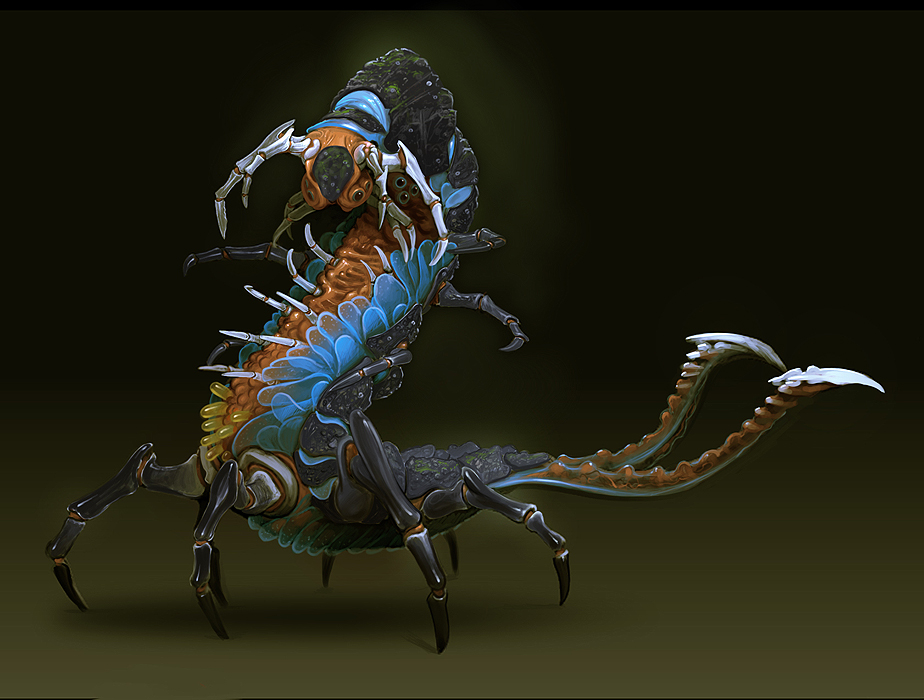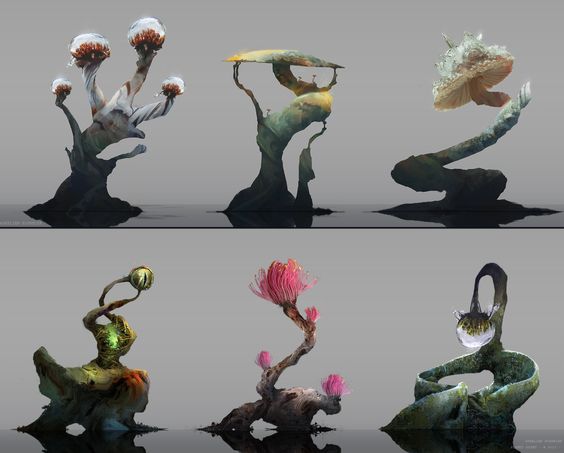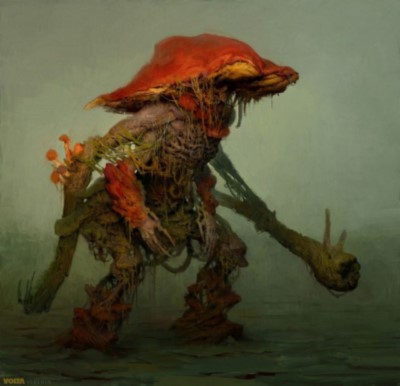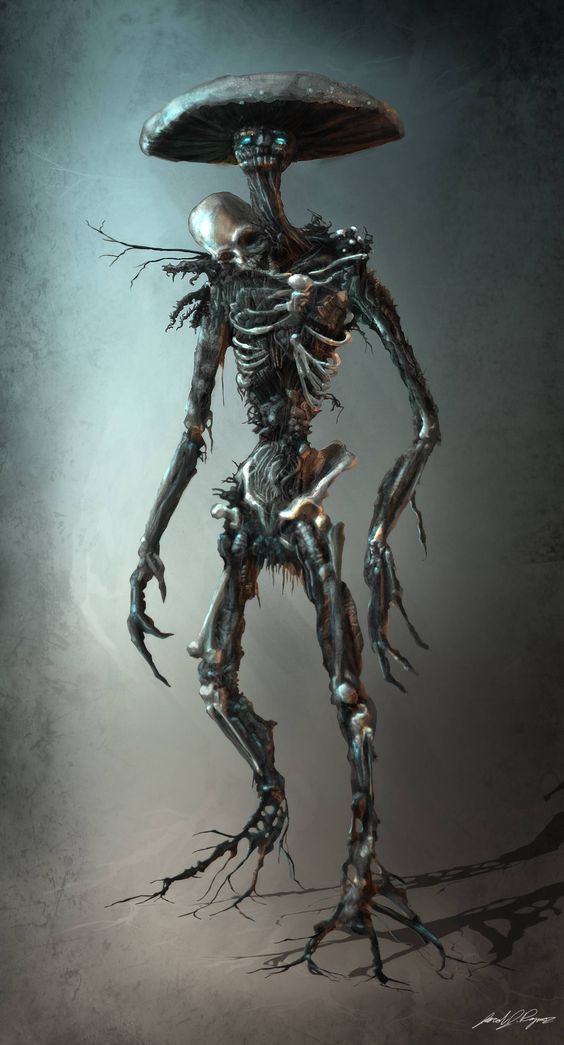Heza, Plague-Eating Parasites
Everything else has failed. The sickness has spread to the heart and the hands are beginning to turn black. We've tried every poultice and potion. There is nothing left to do: fetch the Heza wormling.
Heza are insect-like critters that blur the line between fungi and animal. They spend the active part of their life in a crawling centipede-like form, always in search of suitable hosts. They are known as Plague-Eaters and used as a most desperate means of curing the diseased with a deliberate infection.
Description
The active parasite form of the Heza is that of a long multi-legged and segmented body, covered in a flexible but leather carapace. They are remarkably fast and can skitter without issue up cavern walls and hang onto ceilings, an tactic used to drop onto potential hosts. The 'stomach' side of the Heza is soft and sponge-like, with sprouting growths on either side of its body. The head has gaps in the carapace where fungal tentacles grow, used to smell the air. They have no organs, giving them both remarkable resilience as well flexibility and a Heza can squeeze themselves through any openings large enough to fit their head.
Depending on their parent-fungi, the Heza begin life between the size of finger or a hand, and grow throughout their lives. The largest recorded Heza reached around 46 cm and had been forced to look for much larger prey as smaller animals could no longer be infected.
Examples of a mature Heza in its final fungal state
Life Cycle
The Heza begin and end their lives as infections. From the fungal-tree of a past host
Once a host has been infected, the Heza will slowly root inside it and devour it from the inside. When the tendril reaches the brain or heart, the host is doomed and eventually a new fungi will split the decomposing corpse open. Depending on the size and composition of the host, each fungi differs slightly in appearance, though the parasite-larval they spawn always look the same.
Eventually, it will grow a series of egg-sacks that breeds more of the parasites, and the cycle continues.
Behavior
Heza Parasites are opportunistic ambushers. They usually infect hosts as they sleep, either through the mouth or any open wound, though the Heza have been known to create such a wound if no opening presents itself. Before infection, the Heza survive by grazing on fungi or hunting small insects.
The Heza fungi prefers moist, warm caves and will grow to a much smaller size much more slowly once outside their preferred climate. They are found primarily in the lower reaches of the Inner Shell in clusters here and there. Some are found in the top layer of the Far Deep, and become increasingly rare as the depth continues until they are no longer found.
Attempts to cultivate the fungi have met with mixed success, leading to a limited, unreliable supply for Medikari
Plague-Eating
Though the exact mechanics are not understood, the Heza parasite have been used as a way to treat other infections and illnesses. Scholars of the field theorize that is a case of "like cures like", and that the Heza seeks to eliminate that which would taint or kill its host-prey. Still, the procedure is risky and infection by the Heza is deeply unpleasant.
The parasite is usually administered through the mouth. For this reason, smaller Heza are preferred though some sources claim that the larger ones are more effective at eating out the other plagues. The patient is closely monitored for symptoms of both plague and parasite, then they apply to alcoholic tonic to flush the Heza out.
The procedure is not without its dangers or always successful. A patient infected then denied the tonic by circumstance or malice suffers a cruel death. In other cases, the fungal infection have spread much faster than anticipated and caused lasting damage. Sometimes, the body simply cannot handle the strain of both plague and parasite, and so begins to fail.
But it is a treatment that have worked against terrors that have stumped all other medicine. For the desperate, the Heza may be the only way.
But not all who infect themselves do so seeking a cure. Some seek salvation, a fungal unity with the cavernous world around them. The Society of Shroom is one such cult, where the members deliberately infect themselves and cultivate a variety of parasites in their own flesh. To them, the Heza is not a horror to endure, but something holy.
Worse, they are succeeding, becoming twisted abominations and strange hybrids of blood, flesh and mycelium.
Read about the Society of Shroom
Infection
To be infected by a Heza parasite is an unpleasant way to go. The parasite will attach itself to organs or inside the stomach, then begin to spread. Fungal stalks and roots spread eventually spread through the host body and feed. Even at the early stage, the host will know that something is wrong and can report feeling something move inside them. Symptoms Humans infected by the parasite report increasing pangs of weakness, nausea and loss of balance. As the infection progresses, the tendril roots become visible as black lines under the skin. The hosts' health will rapidly deteriorate once the roots reach vital organs, as they gradually get leeched on and strangled. In some cases the roots have spread up into the windpipes of the infected, leading to difficulty breathing then asphyxiation.Treatment
The fungal infection can be treated with a mixture of strong alcohol and herbal remedies. These will kill the fungi and the parasite, which will then be passed through the infected's waste. The earlier it is administered, the better the infected's chances are for avoiding permanent health damage.But don't wait too long.













I really like your formatting, it's clear and balanced between the main text and the sidebar ! Additionally, the pictures (Y've got very lucky on finding them, I guess.) are wondrous extremely positive to get deeper explanations. Still, I really like the fact that for some peoples, it's not only a negative thing, and make a cult around the aspects of the plague.
Thank you! :D
Creator of Araea, Megacorpolis, and many others.